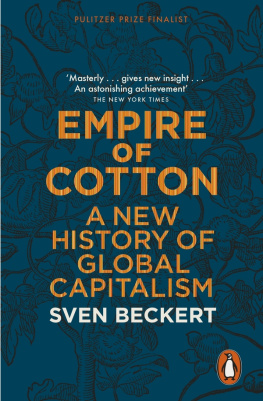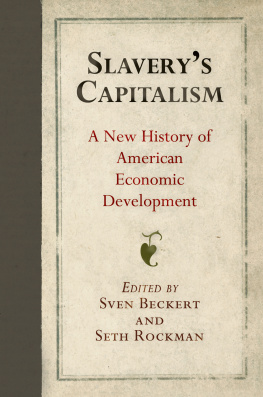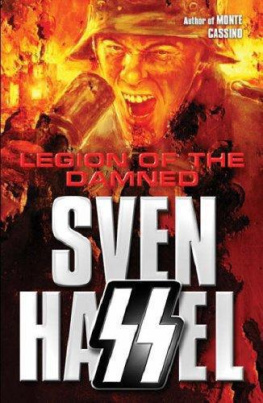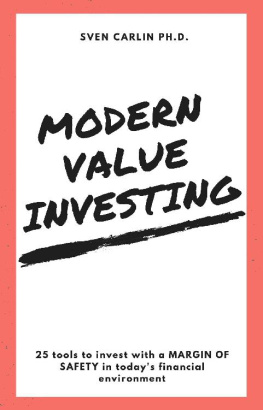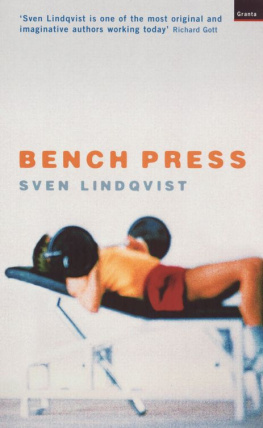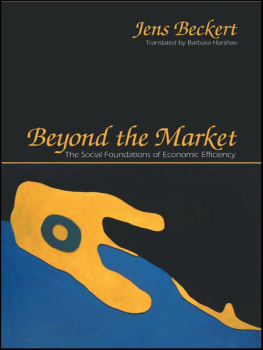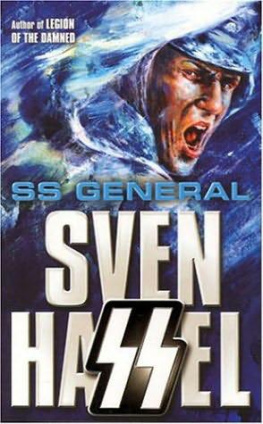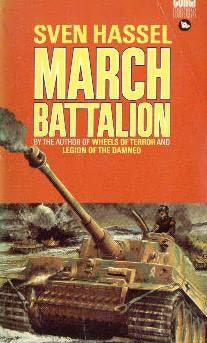Sven Beckert - Empire of Cotton
Here you can read online Sven Beckert - Empire of Cotton full text of the book (entire story) in english for free. Download pdf and epub, get meaning, cover and reviews about this ebook. year: 2014, publisher: Penguin Books Ltd, genre: Politics. Description of the work, (preface) as well as reviews are available. Best literature library LitArk.com created for fans of good reading and offers a wide selection of genres:
Romance novel
Science fiction
Adventure
Detective
Science
History
Home and family
Prose
Art
Politics
Computer
Non-fiction
Religion
Business
Children
Humor
Choose a favorite category and find really read worthwhile books. Enjoy immersion in the world of imagination, feel the emotions of the characters or learn something new for yourself, make an fascinating discovery.
- Book:Empire of Cotton
- Author:
- Publisher:Penguin Books Ltd
- Genre:
- Year:2014
- Rating:3 / 5
- Favourites:Add to favourites
- Your mark:
- 60
- 1
- 2
- 3
- 4
- 5
Empire of Cotton: summary, description and annotation
We offer to read an annotation, description, summary or preface (depends on what the author of the book "Empire of Cotton" wrote himself). If you haven't found the necessary information about the book — write in the comments, we will try to find it.
Empire of Cotton — read online for free the complete book (whole text) full work
Below is the text of the book, divided by pages. System saving the place of the last page read, allows you to conveniently read the book "Empire of Cotton" online for free, without having to search again every time where you left off. Put a bookmark, and you can go to the page where you finished reading at any time.
Font size:
Interval:
Bookmark:



UK | USA | Canada | Ireland | Australia
India | New Zealand | South Africa
Penguin Books is part of the Penguin Random House group of companies whose addresses can be found at global.penguinrandomhouse.com.

First published in the United States of America by Alfred A. Knopf, a division of Random House LLC 2014
First published in Great Britain by Allen Lane 2014
Text copyright Sven Beckert, 2014
Cover: Gossipium Arborem Gotnemsegiar (tree cotton), engraving from De Plantis Aegyptii by Prosper Alpinus (1612), in the Cotton Museum of Cairo (photograph Simone Rivi, in The Cotton Museum of Cairo published by Filmar Spa)
The moral right of the author has been asserted
ISBN: 978-0-141-97997-7

Let the conversation begin...
Follow the Penguin Twitter.com@penguinukbooks
Keep up-to-date with all our stories YouTube.com/penguinbooks
Pin Penguin Books to your Pinterest
Like Penguin Books on Facebook.com/penguinbooks
Find out more about the author and
discover more stories like this at Penguin.co.uk
For Lisa
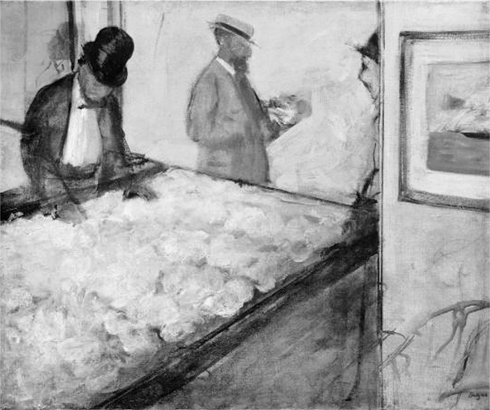
Edgar Degas views the empire of cotton: merchants in New Orleans, 1873.
In late January 1860, the members of the Manchester Chamber of Commerce assembled in that citys town hall for their annual meeting. Prominent among the sixty-eight men who gathered in the center of what was then the most industrialized city in the world were cotton merchants and manufacturers. In the previous eighty years, these men had transformed the surrounding countryside into the hub of something never before seena global web of agriculture, commerce, and industrial production. Merchants bought raw cotton from around the world and took it to British factories, home to two-thirds of the worlds cotton spindles. An army of workers spun that cotton into thread and wove it into finished fabrics; then dealers sent those wares out to the worlds markets.
The assembled gentlemen were in a celebratory mood. President
These self-satisfied cotton manufacturers and merchants had reason to be smug: They stood at the center of a world-spanning empirethe empire of cotton. They ruled over factories in which tens of thousands of workers operated huge spinning machines and noisy power looms. They acquired cotton from the slave plantations of the Americas and sold the products of their mills to markets in the most distant corners of the world. The cotton men debated the affairs of the world with surprising nonchalance, even though their own occupations were almost banalmaking and hawking cotton thread and cloth. They owned noisy, dirty, crowded, and decidedly unrefined factories; they lived in cities black with soot from coal-fueled steam engines; they breathed the stench of human sweat and human waste. They ran an empire, but hardly seemed like emperors.
Only a hundred years earlier, the ancestors of these cotton men would have laughed at the thought of a cotton empire. Cotton was grown in small batches and worked up by the hearth; the cotton industry played a marginal role at best in the United Kingdom. To be sure, some Europeans knew of beautiful Indian muslins, chintzes, and calicoes, what the French called indiennes, arriving in the ports of London, Barcelona, Le Havre, Hamburg, and Trieste. Women and men in the European countryside spun and wove cottons, modest competitors to the finery of the East. In the Americas, in Africa, and especially in Asia, people sowed cotton among their yam, corn, and jowar. They spun the fiber and wove it into the fabrics that their households needed or their rulers demanded. As they had for centuries, even millennia, people in Dhaka, Kano, and Teotihuacn, among many other places, made cotton cloth and applied beautiful colors to it. Some of these fabrics were traded globally. Some were of such extraordinary fineness that contemporaries called them woven wind.
Instead of women on low stools spinning on small wooden wheels in their cottages, or using a distaff and spinning bowl in front of their hut, in 1860 millions of mechanical spindlespowered by steam engines and operated by wage workers, many of them childrenturned for up to fourteen hours a day, producing millions of pounds of yarn. Instead of householders growing cotton and turning it into homespun thread and hand-loomed cloth, millions of slaves labored on plantations in the Americas, thousands of miles away from the hungry factories they supplied, factories that in turn were thousands of miles removed from eventual consumers of the cloth. Instead of caravans carrying West African cloth across the Sahara on camels, steamships plied the worlds oceans, loaded with cotton from the American South or with British-made cotton fabrics. By 1860, the cotton capitalists who assembled to celebrate their accomplishments took as a fact of nature historys first globally integrated cotton manufacturing complex, even though the world they had helped create was of very recent vintage.
But in 1860, the future was nearly as unimaginable as the past. Manufacturers and merchants alike would have scoffed if told how radically the world of cotton would change in the following century. By 1960, most raw cotton came again from Asia, China, the Soviet Union, and India, as did the bulk of cotton yarn and cloth. In Britain, as well as in the rest of Europe and New England, few cotton factories remained. The former centers of cotton manufacturingManchester, Mulhouse, Barmen, and Lowell among themwere littered with abandoned mills and haunted by unemployed workers. Indeed, in 1963 the Liverpool Cotton Association, once one of cottons most important trade associations, sold its furniture at auction. The empire of cotton, at least the part dominated by Europe, had come crashing down.
This book is the story of the rise and fall of the European-dominated empire of cotton. But because of the centrality of cotton, its story is also the story of the making and remaking of global capitalism and with it of the modern world. Foregrounding a global scale of analysis we will learn how, in a remarkably brief period, enterprising entrepreneurs and powerful statesmen in Europe recast the worlds most significant manufacturing industry by combining imperial expansion and slave labor with new machines and wage workers. The very particular organization of trade, production, and consumption they created exploded the disparate worlds of cotton that had existed for millennia. They animated cotton, invested it with world-changing energy, and then used it as a lever to transform the world. Capturing the biological bounty of an ancient plant, and the skills and huge markets of an old industry in Asia, Africa, and the Americas, European entrepreneurs and statesmen built an empire of cotton of tremendous scope and energy. Ironically, their shocking success also awakened the very forces that eventually would marginalize them within the empire they had created.
Font size:
Interval:
Bookmark:
Similar books «Empire of Cotton»
Look at similar books to Empire of Cotton. We have selected literature similar in name and meaning in the hope of providing readers with more options to find new, interesting, not yet read works.
Discussion, reviews of the book Empire of Cotton and just readers' own opinions. Leave your comments, write what you think about the work, its meaning or the main characters. Specify what exactly you liked and what you didn't like, and why you think so.

